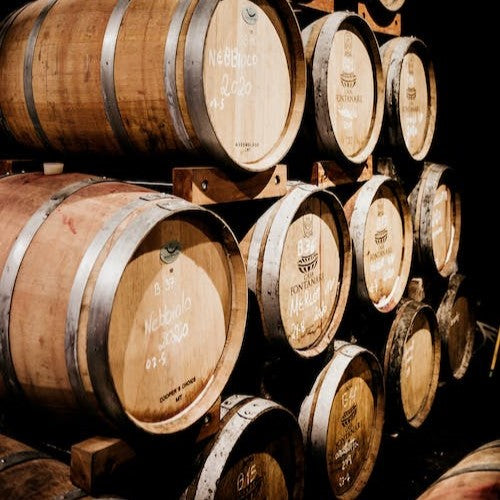In case you missed it, read Part 1.
The 1800s were a watershed decade for the American whiskey business. During this time, bourbon whiskey from Kentucky became a widely produced and consumed variety of whiskey. By the late 1800s, whiskey had become a widespread form of payment throughout much of the United States, and there was a distillery in nearly every town.
American Whiskey's Formative Years
Early European settlers in the Americas planted the seeds for what would become American whiskey. Many colonial farmers planted cereal grains like rye and barley in the 1600s and 1700s. These grains were traditionally used to make beer, but as distillation techniques developed, farmers began exploring the possibility of making distilled spirits.
In the early days of American history, distilling whiskey was typically a regional, family-run business. Farmers grew their own grains, distilled their own whiskey, and sold or bartered the resulting booze among their communities. George Washington opened the first American commercial distillery at his Mount Vernon estate in 1783, but it wasn't until the 1800s that whiskey production really took off.
The Origins of Bourbon's Unique Taste
Despite its common use to describe any American whiskey, "bourbon" refers to a very particular style of whiskey that must adhere to certain guidelines in order to be called "bourbon." It must be matured in new, charred oak barrels, contain at least 51% maize, and be produced in the United States (often Kentucky).
Several things contributed to Bourbon's meteoric ascent to fame in the 1800s. Bourbon's corn-based mash bill was first developed because it was ideally suited to the rich soil of Kentucky, making its manufacture simpler and cheaper than that of other types of whiskey. The whiskey's distinctive flavor, developed in part by aging in charred oak barrels, helped it stand out in a competitive market.
Kentucky became the heartland of American whiskey production as bourbon gained prominence. Location along the Mississippi River gave it a perfect place to carry whiskey to other parts of the country, and the state's limestone-rich water contributed to a distinctive flavor profile in the whiskey.
Production of Whiskey Boomed in the 19th Century
As the population and economy expanded, whiskey distilleries adapted by incorporating steam power into the production process. Before this, whiskey was typically distilled using fire, which made temperature control difficult and led to inconsistent results. Whiskey quality and consistency improved as a result of the increased control over the distillation process made available by steam power.
Not long after, advances in machinery and technology simplified the bottling process and allowed the line speed to be increased. These developments allowed distilleries to produce more whiskey in response to consumer demand, and contemporary bottling technology has allowed for the bottling of whiskey that has been aged for longer periods of time, resulting in a higher standard for the products and more stability.
American Whiskey and Bartering
Whiskey was frequently used as cash in early American society. As farmers and distillers bartered whiskey for other goods and services, it became a frequent medium of exchange in rural areas.
The American practice of bartering persisted well into the nineteenth century. Whiskey was commonly used as a form of payment for labor in cash-strapped border regions.
However, there were issues with using whiskey as cash. Whiskey's worth was often debatable, and disagreements about the spirit's quality were common during trades. Even more disagreements arose regarding the worth of whiskey because the industry was not regulated, and so many unscrupulous producers diluted their product for financial gain.
Whiskey continued to be used as payment into the 1800s despite these obstacles. In order to raise money for the war cause, federal authorities didn't start controlling the whiskey industry until the Civil War.
What Happened to Whiskey Because of the Temperance Movement?
The temperance movement, which sought to decrease Americans' consumption of alcohol, also gained traction during this time period. Movement proponents pointed to the social and health costs of alcohol consumption as well as the general belief that such behavior is morally reprehensible as reasons for its success.
The whiskey industry was profoundly impacted by the many rules and regulations enacted to reduce alcohol use as a result of the temperance movement. In 1851, Maine became the first state to prohibit the manufacture and distribution of alcoholic beverages. When numerous other states followed California's lead and instituted prohibition in the late 1800s, the movement swiftly gained popularity.
How the temperance movement might influence the whiskey industry was a topic of heated debate. The increased government regulation and taxes of the industry was one way the movement impacted independent manufacturers. New markets were opened for whiskey as a result of the resistance many Americans expressed at the time through their drinking.
The 1800s were, in the end, a crucial decade for American whiskey. A combination of factors—including the development of steam power and advances in bottling technology—made Kentucky the epicenter of the American whiskey industry. In many rural places, whiskey served as a type of currency in the prevailing barter economy of the time. Increased government oversight and taxes, as well as the development of new consumer niches, were all results of the temperance movement's influence on the whiskey business. Despite these obstacles, whiskey continued to play a significant role in 20th-century American culture, and its impact may still be seen today.
